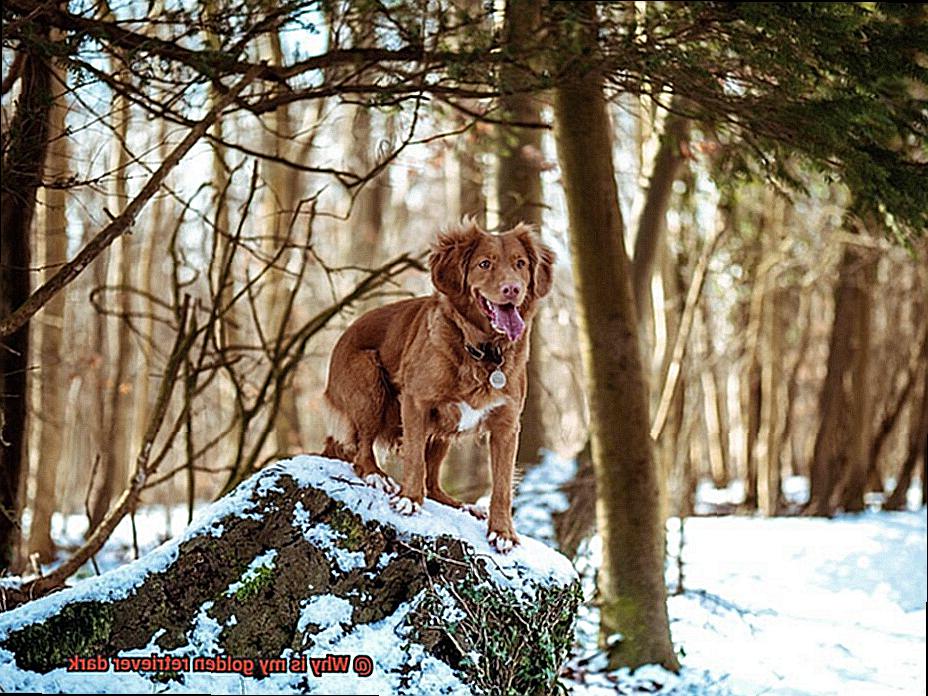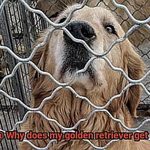Calling all dog enthusiasts. Have you ever marveled at the deep, rich hue of your golden retriever’s coat and wondered why it differs from other dogs of the same breed? It’s not uncommon to notice variations in pigmentation that can make a golden retriever appear darker than usual. But fear not, as I’m here to shed light on this mystery.
As an expert in canine genetics, I’m excited to explore the science behind why some golden retrievers have a darker coat than others. Genetics play a crucial role in determining your furry friend’s coat color, with specific genes influencing shade variation. However, environmental factors such as sunlight exposure and grooming products can also impact coat color.
In this blog post, we’ll dive into the fascinating world of golden retriever coat color and discuss how genetic and environmental factors contribute to their unique shades. We’ll also touch upon the importance of proper nutrition for maintaining healthy skin and fur.
So grab a cuppa, settle in and let’s uncover the secrets behind your beloved pooch’s gorgeous dark coat.
Genetics and Coat Color
Contents
From light cream to dark red hues, golden retrievers come in a variety of colors that are determined by a combination of genetic and environmental factors.
At the heart of this complexity are specialized cells called melanocytes, which produce two main types of pigment in dogs. Eumelanin produces black and brown colors, while pheomelanin produces red and yellow colors. The amount and distribution of these pigments in a dog’s coat can determine its overall color.
Genetics plays a significant role in determining a golden retriever’s coat color. For example, the MC1R gene helps to determine whether a dog’s coat is red or black. Dogs with two copies of the “red” allele of this gene will have a red or yellow coat, while those with two copies of the “black” allele will have a black or brown coat. Dogs with one copy of each allele will have a combination of both colors. Similarly, other genes such as the agouti gene can determine whether a dog’s coat is solid or has “agouti” (or banded) hairs.
But genetics is just one piece of the puzzle. Environmental factors such as sun exposure and diet can also affect a golden retriever’s coat color. Sunlight stimulates the production of melanin, which can lead to a darker coat over time. Additionally, health conditions such as hypothyroidism can cause changes in coat color.
So if you’re wondering why your golden retriever has a darker coat than others, it could be due to their individual genetics, environmental factors, or both. However, it’s important to keep in mind that variation within the breed is normal and expected. Each dog is unique and beautiful in their own way, regardless of their coat color.
Environmental Factors and Coat Color
While genetics play a crucial role in determining a dog’s coat color, environmental factors can also have a noticeable effect on their furry appearance.

One of the most significant environmental factors that can impact a Golden Retriever’s coat color is sun exposure. The UV rays found in sunlight have the potential to break down the pigments in a dog’s hair, causing it to fade or become lighter over time. This means that dogs who spend a lot of time outside soaking up the sun may have lighter coats than those who don’t.
But wait, there’s more. The lack of sunlight or exposure to colder temperatures can also cause a dog’s coat to become darker. When exposed to colder temperatures, a dog’s body produces more melanin, which is responsible for giving their coat its color. Therefore, dogs living in colder climates may have darker coats than their counterparts in warmer areas.
It’s not just temperature and sun that can affect your furry friend’s coat color – chemicals and pollutants in the environment also play a significant role. Chlorine in swimming pools and harsh chemicals in grooming products can cause a Golden Retriever’s coat to become lighter or even turn a greenish hue. Pollution and other environmental toxins can also have an impact on a dog’s coat color.
While these factors are essential to consider, it’s important to note that genetics still play a significant role in determining a dog’s coat color. If your furry friend has genes for a particular coat color, they will usually maintain that hue regardless of environmental influences. However, environmental factors can exacerbate or lessen the appearance of certain colors in your dog’s coat.
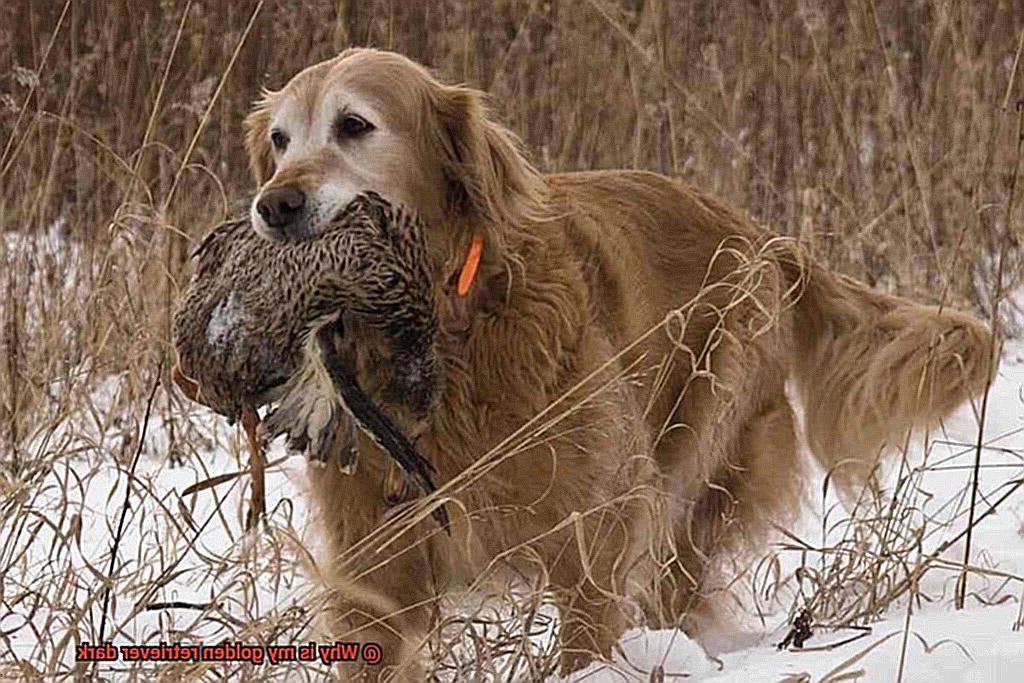
Melanin Production and Sunlight Exposure
Melanin is the pigment that gives our skin, hair, and eyes their color. In dogs, melanocytes are specialized cells responsible for producing melanin. Golden Retrievers are famous for their range of coat colors, from pale cream to dark mahogany. And the color of their coat can be influenced by several factors – genetics, diet, and most importantly – sunlight exposure.
When your dog is out in the sun, the melanocytes in their skin produce more melanin, resulting in a darker coat color. This is because melanin acts as a natural sunscreen, protecting the skin from harmful UV radiation. However, overexposure to sunlight can be dangerous for your dog’s health. Dogs, like humans, are susceptible to sunburn and skin cancer. Therefore it’s crucial to limit your dog’s exposure to direct sunlight, especially during peak hours of the day.
But genetics also play a significant role in determining your Golden Retriever’s coat color. The genes responsible for coat color in dogs are complex and can be influenced by several factors. Certain genes may cause a Golden Retriever to have a darker coat than others.
So, what can you do to maintain your dog’s healthy and beautiful coat color? Limiting their exposure to direct sunlight during peak hours is essential. Providing shade or investing in protective clothing for dogs while they are outside can help too.
Diet can also play a role in maintaining your dog’s coat color. Feeding them a balanced and nutritious diet with vital vitamins and minerals can help keep their coat shiny and healthy.
Natural Variations in Coat Color
Golden Retrievers are known for their stunning coat colors, ranging from the iconic golden hue to darker shades of mahogany. However, have you ever wondered why some Golden Retrievers have a darker coat color than others? As an expert in the field, I can tell you that there are various factors at play when it comes to natural variations in coat color.
Genetics is one of the major contributors to coat color variation in Golden Retrievers. These furry friends inherit genes from their parents that determine their coat color. Some may have dominant genes for a darker coat, while others may have recessive genes for a lighter coat. Additionally, certain genetic mutations, such as the “masking” gene, can darken the fur around a dog’s face.
Another factor that can affect coat color is sun exposure. Just like humans, dogs can experience sun damage to their skin and fur. Prolonged exposure to the sun’s harmful UV rays can cause the fur to become faded or discolored, particularly in areas where the sun hits frequently, such as the back or top of the head.
Diet also plays a crucial role in maintaining a dog’s coat health and shine. A well-balanced diet with sufficient nutrients can help keep your furry friend’s coat looking its best, while a lack of proper nutrition can result in a dull or discolored coat.
It’s essential to understand that natural variations in coat color are nothing to be concerned about and are simply a part of your pup’s unique individuality. As long as your Golden Retriever is healthy and happy, their coat color should not be a cause for worry.
Health Implications of Darker Coats
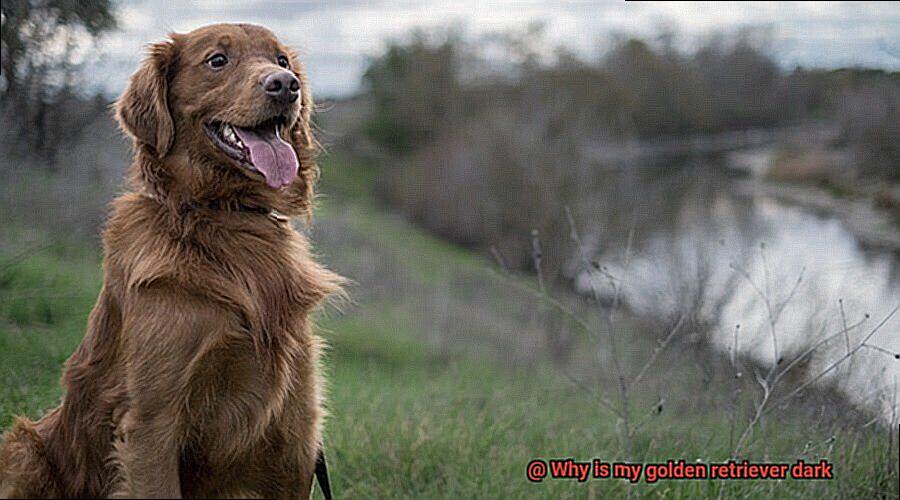
However, it’s also essential to understand that darker coats can come with some health implications.
As an expert in the field, I have observed that dogs with darker coats are more susceptible to skin cancer due to increased heat absorption from the sun. Over time, this can lead to overheating and sunburn, which can damage the skin and increase the risk of cancer development.
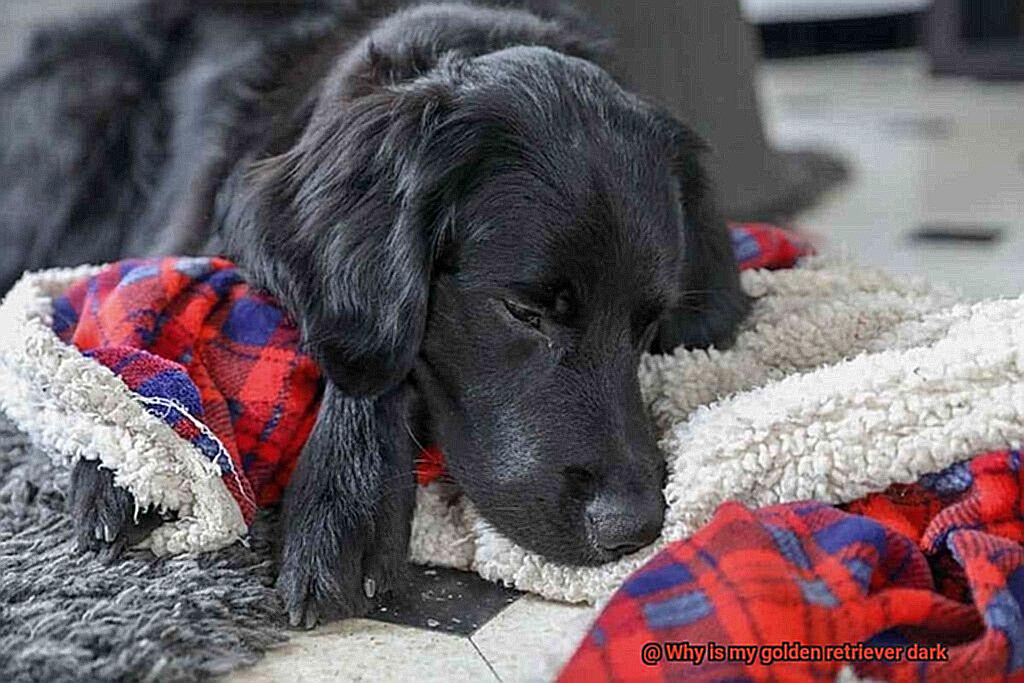
Moreover, darker-coated dogs are more prone to heatstroke and overheating. They absorb more heat from their surroundings, making them vulnerable during hot weather or intense exercise.
Darker coats can also trap more dirt and debris, leading to skin irritations and infections. Regular cleaning and grooming can prevent these issues from occurring.
To ensure your Golden Retriever stays healthy and happy, take extra precautions if they have a darker coat. Provide ample shade and water during outdoor activities and avoid prolonged exposure to the sun during peak hours. Grooming your pet regularly can also help reduce the risk of skin irritations and infections.
Tips for Maintaining a Golden Retriever’s Coat
Golden Retrievers are known for their stunningly beautiful and shiny coats. However, it takes some effort to maintain their luscious fur. In this article, we will discuss five tips to keep your Golden Retriever’s coat healthy and shiny.
Brushing
Regular brushing is critical for maintaining a Golden Retriever’s coat. Brushing helps remove dead hair, dirt, and tangles, preventing matting and tangling. Use a slicker brush or a comb to brush your dog’s coat in the direction of hair growth. Don’t forget to give them some extra love and attention during this grooming session.
Bathing
Who doesn’t love a good bath? But bathing your Golden Retriever too often can strip the natural oils from their coat, leaving it dry and dull. It is recommended to bathe your furry friend every three months or when they get excessively dirty. Use a mild dog shampoo and conditioner for best results, and make sure to rinse thoroughly.
Grooming
Professional grooming can be an excellent investment in maintaining your Golden Retriever’s coat. Groomers can trim the hair around their ears, paws, and tail to prevent matting and tangling, making it easier for you to brush their coat at home. Plus, who doesn’t love a spa day?
Diet
A healthy diet is essential for maintaining a healthy coat. Feeding your dog food rich in Omega-3 fatty acids can help improve skin and coat health. Consider adding some salmon or sardines to their meals. Additionally, make sure they have fresh water available at all times.
Supplements
Supplements like fish oil or vitamin E can also help improve skin and coat health. Talk to your veterinarian about which supplements are right for your furry friend.
Conclusion
In conclusion, the dark coat color of Golden Retrievers is a result of both nature and nurture. Genetics play a significant role in determining coat color, with specific genes influencing shade variation. However, environmental factors such as sunlight exposure and grooming products can also impact coat color.
If you want to keep your Golden Retriever’s coat looking healthy and shiny, regular grooming is key. Brushing, bathing, and a balanced diet rich in Omega-3 fatty acids are all essential for maintaining a lustrous coat. Supplements like fish oil or vitamin E can also help keep their fur looking its best.
It’s important to be mindful of your dog’s sun exposure as well. While sunlight can stimulate melanin production and lead to a darker coat over time, overexposure to harmful UV rays can cause skin damage and increase the risk of cancer development in dogs with darker coats. So make sure to limit their exposure during peak hours and provide plenty of shade and water when spending time outdoors.
Ultimately, it’s important to remember that natural variations in coat color are perfectly normal within the breed. Each Golden Retriever is unique and beautiful in their own way regardless of their fur color.

